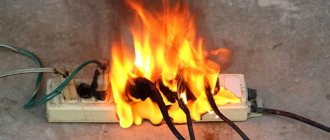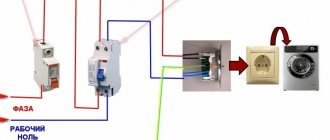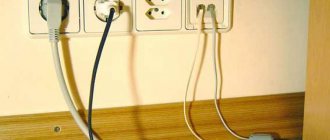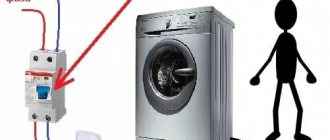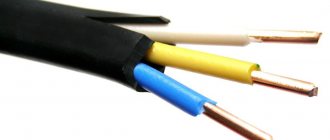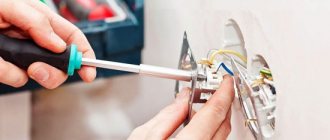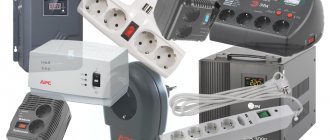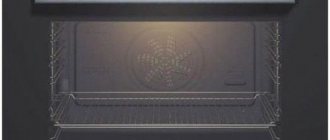A convector is a device used to heat residential premises. The design involves the use of its own heating element to heat the room. This allows you to bypass the mediation of any coolant, making the heating element for the convector the central part of the unit. That is why systems without the use of water or oil as an intermediary are placed in a separate class. The modern convector assembly scheme allows for efficient operation at a fairly low heater temperature.
Tubular electric heater (TEH)
Electric resistance heater, consisting of a heating element with contact rods at the ends, pressed together with the filler into a metal shell in accordance with the drawing. Depending on the area of application and customer requirements, heating elements can have different configurations (shapes).
Tubular heating element design:
1 — Terminals Used to connect to the power source.
2 - Contact rod Being inside the heating element, it remains unheated and determines its cold (non-working) zone. Can be made of nickel-plated, stainless or ordinary steel.
3 - Tubular shell Most often made of stainless steel, copper or titanium.
4 - Heating coil It consists of one, two or three wires made of an alloy with high resistivity, such as chromium-nickel or ferrochrome.
5 — Insulating filler Provides heat transfer from the coil to the shell, insulates from the shell, and in multi-spiral heating elements insulates the coils. Typically, magnesium oxide powder (periclase) is used, which has good thermal conductivity and dielectric strength during pressing.
6 — Sealant Prevents moisture from entering the heater.
7 - Rod insulator Made of ceramic or thermoplastic.
Operating principle: A contact rod (2) having current-carrying terminals (1) is inserted into the shell (3). A heating coil (4) with high ohmic resistance is welded to the rod (2), which determines the working (hot) zone of the heater. To avoid a short circuit to the housing, the spiral (4) is insulated from it by filler (5), which is a dielectric with good thermal conductivity. The ends of the rod are also insulated with special plugs (7). When the spiral (4) is heated, the heat reaches the shell (3) through the insulation (5), which heats the external environment (gas, liquid, solids).
Areas of use:
- in mechanical engineering: for heating molds, dies, casting molds, baths with acids and alkalis, in paint booths, for melting low-melting metals, etc.;
- in the food industry: for digesters, for confectionery production, baking industry, dairy production, etc.;
- in the chemical industry: for the production of rubber, caoutchouc, in the pulp and paper industry, in the oil refining industry, etc.;
- in medicine: for sterilizers, distillers, etc.;
- in everyday life: for space heating, in household electrical appliances (kettles, irons, etc.)
Currently in Russia there are three state standards for heating elements
- GOST 13268-88 - Tubular electric heaters;
- GOST 19108-81 - Tubular electric heaters (TEH) for household heating electrical appliances;
- GOST 4.150-85 - System of product quality indicators. Tubular electric heaters (TEH).
Recommendations for choosing a heater
When choosing a heating element, first understand your intended use.
- Thermal energy transfer mechanism
. Will the object be heated by conduction, which involves direct contact of the surface with the heating element, or will convection or radiation be the transfer mechanism? Different types of heaters use different heating methods.
- Determine the required power supply options
. What voltages and currents are available, AC or DC? Are there any conditions in the intended use environment that may limit the use of certain heater wattage options? For example, to heat oil or petroleum products, special heaters with low power density are needed.
- What are the heating requirements?
Is the heater expected to cycle on and off to maintain temperature? How long does it take to reach the desired temperature? What is the expected heat loss in the intended use environment? Is overheating a problem? The goal should be to establish the correct power density required for the heater, usually measured in watts per square centimeter, that meets the heating requirements of the specific equipment. This may require thermal analysis to determine the required power density.
- What form factor is needed?
? Because some types of heaters are designed with a specific form factor in mind, such as ring heaters and plate heaters, knowing the form factor or geometry of the object being heated will help determine which heater options can be used most effectively.
- What level of temperature control is required for the object being heated?
? The greater the degree of temperature control, the more complex the measurement and monitoring capabilities will be, which can impact heater options and implementation costs.
This article provides a summary of the main types of heaters commonly used in industrial equipment. For more information about our heaters, call us by phone or you can view detailed information about specific products on our website in the Heatl heater catalog.
Heating elements for electroplating
They are made with a shell of quartz glass, stainless steel or titanium and are designed for heating various substances and solutions, including aggressive ones. Mainly used in electroplating and chemical industries. A minimum immersion depth mark is applied to the product shell. During operation, it is necessary that the level of the heated liquid is above this mark. Submersible heating elements are used for heating organic acids, solutions containing the metals nickel Ni, chromium Cr, iron Fe, copper Cu, zinc Zn, etc., tap and sea water, fluxes, etc.
Device classification
A heating element is a part of the mechanism of a certain device that is used to heat the environment, a specific device or substance. The diagram of a simple boiler looks like this:
Photo - boiler diagram
There are these types of parts:
- Open(Lukey);
- Closed (Galant), X-DUOS);
- Sealed (RTS – PTC, ENGL-1).
Open heating micathermic elements (STIC) are most often made of nichrome. For example, as portable heaters or boilers. Nichrome wire is wound on top of a metal working surface. Sometimes a manual heater was even used; it could easily be made with your own hands; a piece of wire was passed through wooden holders and connected to the power supply.
Photo - an example of using nichrome thread
Previously, every electrician had in his supply a fair number of coils of wire of various sections. Thanks to simple calculations, it was possible to quickly calculate how much and what kind of wire needed to be wound to obtain a certain power.
Photo - wire diameter and required power
But open heaters have many disadvantages :
- High fire hazard. If a little dust gets on the hot wire, a spark may appear and a fire may start;
- High probability of short circuit. Some craftsmen turn on several similar heaters from one outlet, which greatly overloads the network;
- Low efficiency. Such wire heating elements are considered extremely uneconomical.
Despite the fact that such a household boiler can be made in a matter of minutes, now they are used extremely rarely.
Photo - heating film
Such heating means have been replaced by a tubular heating element or heating element, which is now used for a boiler, washing machine, boilers and other appliances. A heating element is a closed pipe in which a contact or thermocouple is placed. There are two types of heating elements: “wet” and “dry”. Wet ones come into contact with liquid, so they often suffer from the harmful effects of water on the metal. Dry ones are protected from it by a special surface, a wall. They take a little longer to heat up the water, but have a much longer service life. On average, wet heaters are replaced every year.
These devices are rarely used for heating, but they do an excellent job of heating water. The main working part is also a nichrome spiral, but it is protected by a tube. Accordingly, there can be no contact with her. The free space in the pipe is filled with certain chemical compounds, as a result of which a dense and closed tube is formed.
Heating elements are now often equipped with a thermostat.
Sealed heaters are the same heating elements, but they are completely closed from the environment, not counting 2 contacts. Used to heat water, various surfaces, etc. The ceramic heating element is safe, heats up quickly and holds the temperature well.
Photo - heating element for stove
Heating elements can also be classified by area of use; different types are used for ovens, electric stoves, convectors and soldering irons. Flexible spirals are used for oven and hob surfaces. They can cover a large area without compromising the integrity of the electric arc. The oven, air fryer and incubator use the same type of heating elements, but with different power parameters.
Types of heating elements for stoves:
- Cast iron pancakes;
- High Light;
- Halogen.
Cast iron heaters are used in the simplest stoves and ovens. They can be located at the top of the cabinet or at the bottom. Under the cast iron plate there is a spiral of chromium, nickel and other conductive alloys, sometimes silicon carbide heating elements (SEC). Thanks to this design, the disk heats up for a long time, but at the same time cools down slowly.
High Light is an infrared heating strip, often a 12 volt carbon heater used to heat an incubator or small room as an electric convector (Double-U-Force). The ring tape heater can be installed for household convectors, electric ovens, ovens, Wasteland toasters.
Halogen and quartz heating elements are used in most modern electric stoves. They are known for their high heating and cooling speed, which ensures high temperature and safety of the device. High-temperature coils are often compared to gas burners because they heat up quickly and operate strictly until they turn off.
Photo - heater made of nichrome and tube
To improve the operation of heating devices, additional elements are often used, for example, for a muffle furnace these are electric annealing heaters, and for boilers - special thermal layers. Such thick film “wraps” help maintain the temperature balance at a certain level even after turning off the power. A thermos effect is created without heating the air.
Video: heating elements for soldering equipment
High temperature heating elements
They are widely used in electric furnaces at temperatures up to 1700°C, and sometimes up to 1800°C. Depending on operating temperatures, they are made on the basis of lanthanum chromite, silicon carbide, molybdenum disilicide and other alloys that have a high oxidation temperature and high corrosion resistance. They can be used in both continuous and intermittent operating modes with complete cooling between cycles.
The figure shows the following heating elements: a - based on lanthanum chromite (operating temperature up to 1800°C); b - based on silicon carbide (up to 1400°C); c - based on molybdenum disilicide (up to 1800°C); d - fechral (up to 1400°C).
Flexible heating elements
Their principle of operation is based on the release of heat by wires that have high resistance when electric current passes through them. Can be bent into any shape directly by the user. There are options for attaching to the surface using self-adhesive film. With optimal heat transfer, the operating temperature reaches 200°C (short term up to 230°C). Typically used for space heating, underfloor heating, anti-icing, medical, food and aerospace applications.
Flexible heating cables and tapes
Designed to maintain specified temperatures (up to 180°C), including in explosive areas. They are a fibrous heating element made of nichrome, braided with fiberglass and covered with a sealing sheath of polyethylene or rubber. Due to the large heating surface, reliable electrical and waterproofing, low weight and elasticity, they are used in the gas, chemical, and oil industries for heating and compensating heat losses of pipelines, heat exchangers, as well as in everyday life.
Scope of application of tape heaters
ENGL is used both in everyday life and in industry. The tapes help prevent water and sewer pipes from freezing. Moreover, by choosing a heater with increased power and increasing the number of turns, it is possible to obtain water, other liquid or substance at a given temperature.
In addition, flexible tape heaters are used:
- for insulation of attics, verandas, attics;
- to maintain the temperature of petroleum products. For example, with high-quality insulation of tanks, bitumen will not have to be melted before use;
- in the metalworking industry for heating crucibles, molds, stamping equipment;
- in polymerization ovens in factories producing varnishes and paints;
- in injection molding machines and extruders;
- in drying machines, ovens;
- in fire protection systems.
The widespread use of tapes is facilitated by their safety, ease of installation, and ability to take almost any shape. Thus, the minimum bending radius is only 20 mm, and installation can be carried out at -50 0C.
Flat heating elements
Their design consists of a sheet metal body 0.25–0.5 mm thick, made of carbon or stainless steel, inside of which there is a heating element made of a material with high electrical resistance (nichrome wire, tape). The coils of the product are insulated from each other and from the body using insulating material (ceramics (a), silicone (b), micanite (c), etc.). Main advantages: small thickness, uniform heating over the entire surface, efficiency, environmental safety, high reliability and durability. They are used for heating premises (convectors, air heaters, heat guns, heat curtains), in stamping and vulcanizing presses, in the chemical industry (heating baths with an aggressive environment), in household products (drying shoes, boiling mugs, etc.)
Ceramic infrared heating elements
Such products consist of a ceramic body into which nichrome spirals are mounted. Under the influence of electric current, this element heats up to a temperature of 450-470°C. The energy of the heated spiral heats up the ceramic body, the surface of which in turn begins to emit a stream of infrared energy, acting as a filter and normalizing the radiation of the spiral. Widely used in infrared cabins/saunas, chemical industry, glass making equipment, etc.
Which convector to choose
If we talk about which heater is better to choose, the answer will be ambiguous. With all the obvious advantages, each type has its own disadvantages. For example, the tubular element has the longest glow time. During active operation, it can make clicking sounds and squeaks caused by the expansion of the structure. In turn, the monolithic element scares off most buyers due to its high cost. Not everyone is willing to overpay for a significant degree of protection and minimal heat loss.
Most often, consultants in stores recommend purchasing convectors with a monolithic element or heating element.
The decision about which convector is more efficient should be made based on the characteristics of the heated room.
- If the room is not humid and the speed of air heating does not play a key role, a conventional heating element is best suited.
- However, if it is necessary to constantly maintain comfortable conditions in the room, it would be more correct to give preference to a monolithic element. An efficient convection system will allow you to save a little on electricity.
- You can also turn your attention to combined type models, such as an infrared heater with a convection function. This device combines heating through a heating element and an infrared element, which allows you to quickly warm up the room with little electrical energy consumption.
Experts advise paying attention not only to the heating element. Maximum operating power, spatial arrangement, mobility and ergonomics of the housing also make a significant contribution to efficiency. Carefully study the technical characteristics of the device, and you can easily choose the convector that suits you.
Infrared quartz emitters
The emitters are quartz tubes with a resistive spiral inside. Thermal radiation emanating from the heating element is absorbed by surrounding objects, which, when heated, reflect heat, as a result of which the air temperature rises. Due to the short response time, it is recommended to use such devices primarily in cyclical or frequently interrupted work processes: drying fruits and vegetables/paint/varnish/fabrics, pasteurization, sterilization, thermo- and vacuum forming, keeping food hot. They are also used to heat rooms.
Applications and industries
The areas of application of heaters are varied. One way to characterize the use of heaters is to divide the use by whether the heater's function is direct air heating, water heating, non-contact heating, or contact heating. With this in mind, common applications for space heaters include:
- Air heating
in homes, buildings, cars, trucks, trains, airplanes or other enclosed structures for overall environmental comfort using convection
- Water heating for domestic use
or consumption by conduction, including water for bathing, pools and spas, laundry or other applications
- Heating materials such as glues, adhesives, plastics, rubbers or other moldable substances
, as part of a manufacturing process to improve the ductility or flow of materials or to facilitate curing
- Heating drums, containers and other solid forms
which may contain liquids or solids and which are heated by conduction from the heater to the container and its contents
- Heating of pipes and valves
to improve the flow of materials in piping systems and prevent damage due to low temperature conditions.
- Heating objects and people using infrared energy
for speeding up drying, thermoforming or using convective heating in open areas.
- Heating of a liquid
through direct contact
with an immersed heat source
